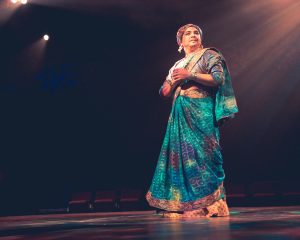‘House of Joy’ at San Diego Repertory Theatre: More Spectacle Than Persuasive Drama
When I hear someone whining about the excesses of “political correctness,” my eyes roll automatically. I give my readers permission to commence such reactions immediately as I describe San Diego Repertory Theatre’s flamboyant new production of House of Joy in the Lyceum Space.
Allow me to go down the P.C. list:
Exotic, non-western location; check: a harem in 17th-century India.
Female, p.o.c. playwright; check: Madhuri Shekar.
Cast of strong, independent female characters; check: all seven of them.
Men reduced to superfluous roles; check: one eunuch and one wimp.
Female revenge; check: evil Emperor (off-stage) brutally assassinated.

Devereau Chumrau, Ulka Simone Mohanty & TaiReikca L.A. (l. to r.) [photo (c.) Val Dostalek]
In her program notes, Shekar has explained that her play is rooted in actual events from Indian history—the Emperor who built the Taj Mahal had two sons who incited a civil war that was negotiated by their sister—but that she has fashioned her own story and set of characters in House of Joy. Members of the audience soon learn the irony of Shekar’s title: although the harem is described as paradise—a house of joy—it is a treacherous place of confinement, controlled by rigid rules, physical abuse, and even murder. And just in case anyone should foolishly entertain the expectation that the play’s harem setting might include a Hugh Heffner inspired coterie of female pulchritude on display, House of Joy includes not a scintilla of tempting flesh. Most of the stage action takes place among the appropriately attired harem guards, and when a male physician is actually ushered into the interior of the harem to attend the ailing Princess Mariyam, she is completely hidden under an opaque tent. The poor doctor is commanded to make a diagnosis without so much as taking her pulse–touching a Princess is forbidden!
The Rep’s production–the first since the play’s premiere last year–is a swashbuckling affair that sports glittering, bejeweled costumes by Jennifer Brawn

Tamara Rodriguez [photo (c.) Val Dostalek]
And what of the plot’s villian, the abusive Emperor? Shekar gives him no place on stage–he is simply an offstage angry voice. Another generic character with a major plot function. Filling in for the offstage bad guy, Mondis Vakili struggled to convince us that this imperious Princess who used the majority of her time on stage to boss and belittle everyone of lesser station was going to turn everything around, open doors and let in new ideas, after she offs the Emperor and crowns herself Empress of the kingdom. Yeah, right.
On the other hand, Shekar lavished time on secondary characters. We watched the two low-ranking elite guards Devereau Chumrau as Hamida and TaReikca L.A. as Roshni play games to pass the time on duty and undergo rigorous training under the experienced leadership of Ulka Simone Mohanty Gulal, who at least projected a reasonable facsimile of a stern drill sergeant. While Hamida does have an important role in Princess Mariyam’s escape, there was little in Shekar’s exposition of Hamida’s persona in the early part of the play that predicted her heroic function at the denouement. TaReikca L.A.’s sassy attitude and street-wise banter easily endeared her to the audience, and a romance that blossomed between her and Karthik Srinivasan’s mild-mannered physician–his name is Thermometer, please don’t ask–enlivened the second act. But it was is no way essential to the dramatic development.

Shaun Tauzon [photo (c.) Val Dostalek]
Artistic Director Sam Woodhouse shared the stage direction with Arpita Mukherjee, and they deserve credit for giving this weak script as much vitality and credibility as it had on opening night. Shekar’s newest play, Dhaba on Devon Avenue, is slated for a premiere later this spring at Chicago’s much lauded Victory Gardens Theatre. I hope that a contemporary setting will provide the opportunity for a tighter and more convincing plot.
San Diego Repertory Theatre opened “House of Joy” by Madhuri Shekar on March 11, 2020, at the Lyceum Theatre in downtown San Diego. The play is slated to run through March 29, 2020.

Ken Herman, a classically trained pianist and organist, has covered music for the San Diego Union, the Los Angeles Times’ San Diego Edition, and for sandiego.com. He has won numerous awards, including first place for Live Performance and Opera Reviews in the 2017, the 2018, and the 2019 Excellence in Journalism Awards competition held by the San Diego Press Club. A Chicago native, he came to San Diego to pursue a graduate degree and stayed.Read more…


